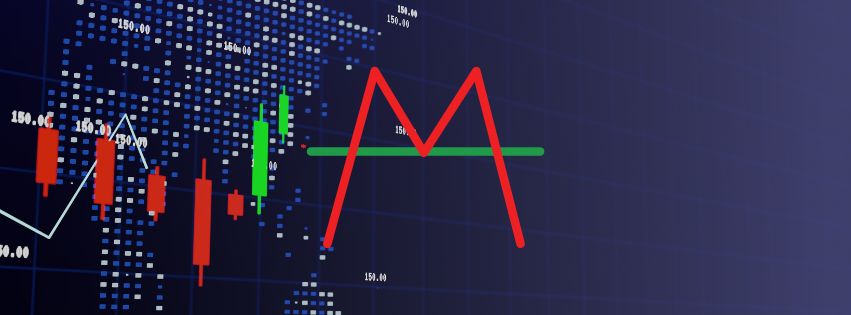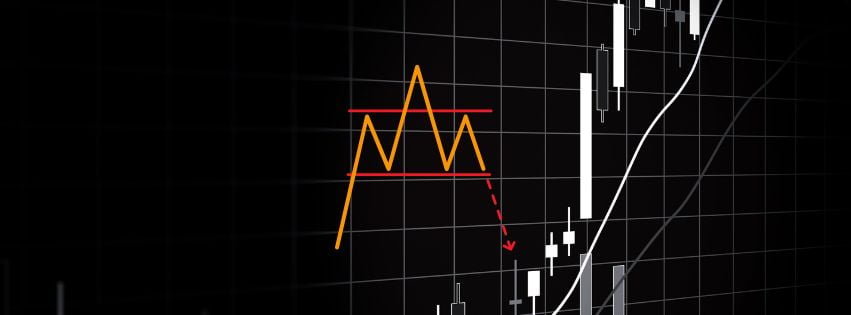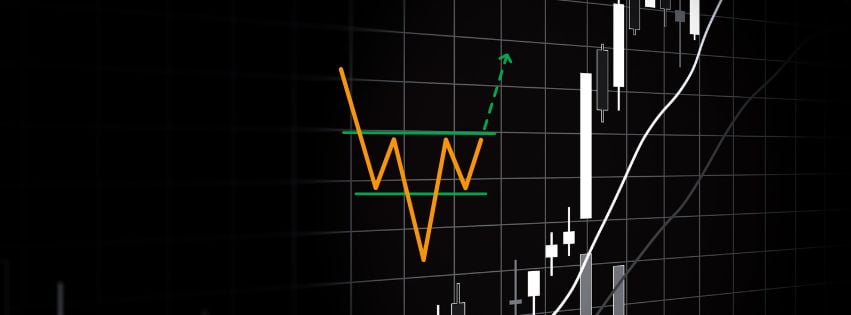The wedge pattern is a chart pattern in technical analysis that can be identified by two converging trend lines. Its presence in chart patterns is considered one of the most unique, as it can exist in any part of a trend on a chart and can be viewed as either a trend reversal or continuation pattern, depending on market dynamics.
A price breakout from wedge patterns often leads to significant price movements either upward or downward, making them favored by many experienced traders. In this article, we will explore techniques for identifying and trading wedges pattern through multiple forex trading examples.
Wedge Pattern in Trading
The Wedge Pattern is a chart pattern that formed by two converging trend lines in a candlestick chart, where price of an asset may fluctuate within the range formed by these two lines. These trend lines can be either in ascending or descending slope, and by justify through how the both lines converge, it can be characterized into two types of wedge pattern:
Rising Wedge (Ascending Wedge)
Formed by two converging line sloping upward. Considered as a bearish reversal pattern.
Falling Wedge (Descending Wedge)
Formed by two converging line sloping downward. Considered as a bullish reversal pattern.
As the two lines gradually converge to form the wedge, the converging price action normally indicates a period of decreasing in market volatility and signals an impending breakout.
The breakout can be either downward in a rising wedge or upward in a falling wedge, leading to a significant rise or fall in price after the breakout. This makes the wedge pattern one of the most closely watched chart patterns in technical analysis.
Although wedge patterns are generally considered reversal patterns, they do not necessarily need to appear at the end of a trend like double top or double bottom patterns do. In some cases, they can be considered trend continuation patterns.
To better understand wedge patterns, in the following section, we will explore in depth how different types of wedge patterns actually work and how they can be applied to trading.
Rising Wedge Pattern
The Rising Wedge Pattern (Ascending Wedge Pattern) is formed by two converging trendlines that slope upwards. As the price moves higher, price volatility and range decrease within the wedge, with the upper trendline serving as resistance and the lower trendline serving as support.
1. Rising Wedge in Downtrend
The ascending wedge is generally considered a bearish reversal pattern, particularly when it appears in an uptrend. In the most ideal scenario, the price will eventually break below the lower support line, leading to a significant decline in price.
Here’s why: when we look at it from the perspective of market sentiment and interpret it from its forming process:
- In an uptrend, bears make multiple attempts to short the price, leading to the new high being barely higher than the previous high, indicating weakening upside momentum.
- With every new high formed, there is a significant pullback, but the lows of these pullbacks are still higher than the previous lows.
- After multiple attempts, the bulls eventually wane, the price breaks below the support line, and this leads to a significant decline in price.
2. Rising Wedge in Downtrend
Despite being known as a bearish reversal pattern, a rising wedge that appears in a downtrend may indicate a potential continuation of the downtrend rather than a reversal.
In such cases, a rising wedge can be interpreted as a temporary rebound or consolidation within the larger downtrend. This can indicate a lack of strong buying strength supporting the upside momentum in a downtrend.
Therefore, a rising wedge can generally be considered a bearish signal in most cases, whether it appears in a downtrend or an uptrend.
Trading Rising Wedge Breakout
Considering the ascending wedge pattern in an uptrend as a bearish reversal, the primary trading opportunity lies in short-selling when the price breakout below the support line.
Below is an example of a rising wedge pattern in forex, specifically in the hourly chart of AUD/USD, where we will explain the trading opportunities in detail.
In the rising wedge chart below, the highs marked with letters (A), (B), (C), and (D) form the upper resistance trendline, and the lows marked with lowercase letters (a), (b), and (c) form the lower support trendline.
1. Rising Wedge Breakout
The rising wedge pattern breakout would essentially be the main trading opportunity in the pattern. In the AUD/USD above, at the point that marked with the number 1 is the most typical entry for a short-selling trade in a rising wedge pattern.
Although there is a certain amount of decline shortly after the downward breakout, the substantial drop only occurs a day later when the price breaks below the previous low at point (c). In the segment of price movement between point C and the number 3, a small head and shoulders pattern is actually formed, which further confirms the validity of the ascending wedge pattern.
Comparing the prices at the number 1 and point D, it is evident that point D provides a better entry price for a short trade. However, entering a short trade at point D carries a higher risk of being stopped out because the ascending wedge pattern could also break out to the upside, which we will explain in detail in the next chapter.
2. Rising Wedge in Consolidated Range
In this pattern, the points (C) would present a first entry point for some experienced traders. By connecting the point (AB) and the point (ab), traders may immediately identify the rising wedge pattern formed at this stage. Point (C) would simply present the opportunity for short-selling the resistance trend line formed in the rising wedge.
When the price pulls back to point (c), we may find that it is the support level of the ascending trendline connecting the lows at points (a) and (b), and also the support level of the previous high at point (B). Price finding support at point (c) presents a short-term buying opportunity with the target being the upper resistance trendline.
At this point, the formation of the ascending wedge pattern is largely clear. Subsequently, when the price rises again to the upper resistance line at point (D) and encounters resistance, it presents another clear short-selling opportunity, given that a rising wedge is considered a bearish pattern.
In fact, the trading opportunities at this stage of ascending wedge pattern essentially involve the simply theory of support and resistance line. When the price rises and touches the resistance line, it presents a short-selling opportunity, while a price drop that holds steady at the support line presents a buying opportunity.
Rising Wedge Bullish Breakout
Despite being known as a bearish pattern, a bullish breakout in a rising wedge is not uncommon. Essentially, the wedge pattern is derived from the ascending channel pattern, meaning that a rising wedge still poses the possibility of either a bullish breakout or a bearish breakout.
Below is an example from the S&P 500 Index daily chart, where the rising wedge pattern ultimately formed a bullish breakout.
For experienced traders, identifying a rising wedge pattern does not necessarily mean that they will trade the pattern with a bearish expectation. Instead, they will trade based on the breakout direction.
In the rising wedge pattern in the S&P 500 Index example above, the bullish breakout above the upper resistance line provided two buying opportunities. As mentioned, trading the wedge pattern is essentially based on the support and resistance concept. Breaking above the upper resistance suggests that the upper resistance line is now turning into support, presenting a buying opportunity on the support line retest.
Falling Wedge Pattern
The Falling Wedge Pattern (Descending Wedge) is formed by two converging trend lines sloping downwards, with the upper line acting as resistance and the lower line as support. As the market continues to decline, the price movement within the descending wedge becomes smaller. In the most ideal case, the price eventually breaks upward, leading to a significant rise in price.
Similar to its counterpart, the falling wedge pattern can be identified as a continuation or reversal pattern depending on where it appear. If falling wedge appears in a extended downtrends, this may suggests the potential of bullish reversal; while falling wedge appears in an major uptrend may suggests a potential continuation in the uptrend.
We may interpret the market dynamics of the falling wedge pattern meaning as follows:
- In a bearish market, the bulls repeatedly support the buying strength, so each new low is not much lower than the previous low.
- After each new low, there is a significant rebound, but the rebound fails to surpass the previous high.
- Eventually, after a few attempts by the bulls, the bearish forces wane, leading to a price breakout above the resistance, causing the price to rise rapidly.
It is also worth noting that similar to the bullish rising wedge breakout, the falling wedge, despite being generally considered a bullish pattern, can sometimes result in a bearish breakout. Therefore, when trading the descending wedge, traders should also remain flexible and consider on the possibility of both breakout directions.
Trading Falling Wedge Breakout
Below is a two-hour chart of the EUR/USD pair, illustrating a falling wedge pattern. In fact, this wedge pattern can only be identified in the later stages of the pattern. We are using this case to explain a specific key point: Wedge pattern does not necessarily require an upper or lower line to serve as a support or resistance.
In this case, the support line of the pattern can be drawn when price movement came to point B, however, the wedge pattern usually can only be identified by some experienced traders when it comes to point 2.
The upper line of the descending wedge above is not considered as an effective resistance line as we normally require at least two highs to confirmed the resistance line. However, this may still consider a valid falling wedge pattern, which the price rises significantly after the upside breakout.
A descending wedge does not necessarily require an upper resistance line and a lower support line. As long as the candlestick pattern converges downward, with lower highs and lower lows, it can be traded as a descending wedge. When the market reaches the final convergence area and breaks through the key resistance (marked at position 3), it presents a buying opportunity.
In addition to trading this movement as a descending wedge, the longer pattern formed by the blue dashed line and the lower support line of the descending wedge can also be traded as a broadening wedge. The next chapter will provide a detailed explanation of this.
Broadening Wedge Pattern
1. Broadening Wedge Formation
A wedge pattern is usually converging toward the upside or downside, however, in some scenario, it can be in expanding form, which known as the Broadening Wedge or the Widening Wedge. In a broadening wedge, the wedge can in expanding form toward the upside or downside.
Similarly to the regular wedge pattern, the broadening wedge can be characterized into two types of broadening wedge. The rising broadening wedge generally seen as a bearish signal, while falling broadening wedge seen as a bullish signal.
Rising Broadening Wedge
Falling Broadening Wedge
2. Example of Trading the Broadening Wedge
Using the Hang Seng Index daily chart below, which includes an example of a descending broadening wedge:
In this pattern, both the upper and lower lines work as support and resistance. The chart marks three key positions on the resistance line with the numbers 1, 2, and 3, and marks three key positions on the support line with the letters A, B, and C.
When the Hang Seng Index reaches point A and finds support, the potential formation of a descending broadening wedge can be identified at this stage. At the same time, the upper resistance line can be drawn by connecting the two previous highs. At the point marked by number 1, the upper resistance line can be confirmed when the price is rejected, confirming the formation of the broadening wedge pattern.
Points A, B, and C are the short-term buying opportunities during the formation of this pattern, while the points marked by the numbers 1 and 2 are short-term selling opportunities.
When the price breaks through the resistance line of the descending broadening wedge at point 3, it is considered the most ideal point for going long, and also the biggest trading opportunity in the entire pattern.
Additionally, the price trend from point 1 to point 4 forms a double bottom pattern breakout, further confirming the validity of the descending broadening wedge.
Wedge Pattern: Entry, Target & Stop-Loss
1. Wedge Pattern Entry & Stop-loss
Although significant price movement may often occur after the wedge pattern breakout, this is not always the case. In the ascending wedge on the EUR/USD four-hour chart below, the price did not experience a significant decline after the breakout.
In the EUR/USD wedge pattern, shortly after the price broke below the support line of the ascending wedge, it experienced a significant rebound and retest the extended line of the broken support (marked by the number 2). These includes two very valuable wedge trading insights:
1. Entry on trendline retest
After breaking below the support line of the ascending wedge, the price often rebounds to retest this line, similar to neckline retest in head & shoulder pattern. When the retest is resisted, it provides a another short-entry opportunity for this rising wedge pattern.
2. Setting the stop-loss
After the price breaks below the support line of the ascending wedge, the stop-loss should be set above the highest point of the pattern to reduce the risk of being stopped out unnecessarily.
2. Wedge Pattern Target
Wedge patterns are very worthwhile trading patterns, however, unlike those double top or double bottom patterns, setting a profit target for trading the wedge pattern breakout can be very tricky.
The most reliable method is to set the target at the previous high or low. However, if the risk-reward ratio is reasonable, aggressive traders may consider to take at least 50% of the price range of the entire pattern as their price target when trading the wedge pattern.
Summary: Wedge Pattern
The reason why a wedge pattern breakout is often accompanied by a rapid rise or fall in prices is that the formation of the wedge is the result of a tug-of-war between market bulls and bears. Once one side concedes, they not only close out their positions to stop losses but may also establish counter positions to recover their losses. The combination of stop-loss closures and the establishment of counter positions can propel the price into a significant movement following the breakout.
The wedge pattern is essentially derived from the ascending or descending channel. Although a typical wedge pattern consists of an upper and a lower boundary, which act as resistance and support lines respectively, these lines are not essential conditions for a wedge.
As long as the following price movement characteristics are met, the pattern can be traded as a wedge:
- Rising Wedge: Both the highs and lows are continuously rising. When the price breaks above a previous high or falls below a previous low, it presents an opportunity to enter a trade.
- Falling Wedge: Both the lows and highs are continuously falling. When the price breaks below a previous low or rises above a previous high, it presents an opportunity to enter a trade.
Whether it is an ascending wedge, descending wedge, or broadening wedge, breakouts can occur in either direction. Understanding and mastering the fundamental concepts of technical analysis—trendlines and support/resistance—along with following the trend direction of the breakout, are key to trading wedge patterns.






